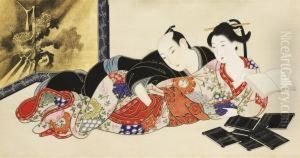Setsuzan Paintings
Setsuzan was a pseudonym for a Japanese artist known by the real name Kawanabe Kyōsai II. He was born in 1886 and primarily worked during the late Meiji and early Showa periods of Japan. Setsuzan was not as widely recognized as his predecessor, Kawanabe Kyōsai, who was a prominent and prolific painter and printmaker, often remembered for his associations with the ukiyo-e style and his often satirical and humorous works.
Setsuzan, whose work is less documented and studied, inherited the artistic lineage of Kawanabe Kyōsai, whose influence can be seen in Setsuzan's style and subject matter. Setsuzan's works included traditional Japanese themes and occasionally reflected the shifting tides of Japanese art during a period of rapid modernization and Western influence. As with many artists of his time, Setsuzan would have been trained in the techniques of the past while grappling with the incursions of modernity and the changing tastes of the art market.
Unfortunately, little is known about Setsuzan’s personal life or career due to the scarcity of records, and his work is often overshadowed by the more famous Kawanabe Kyōsai. Setsuzan's death in 1942 occurred during World War II, a time when Japan was undergoing tremendous upheaval, which may further contribute to the limited documentation and recognition of his contributions to the art world. Today, Setsuzan's works, when they are found, provide an insight into the continuity and change within the tradition of Japanese painting during a transformative period in Japan's history.
